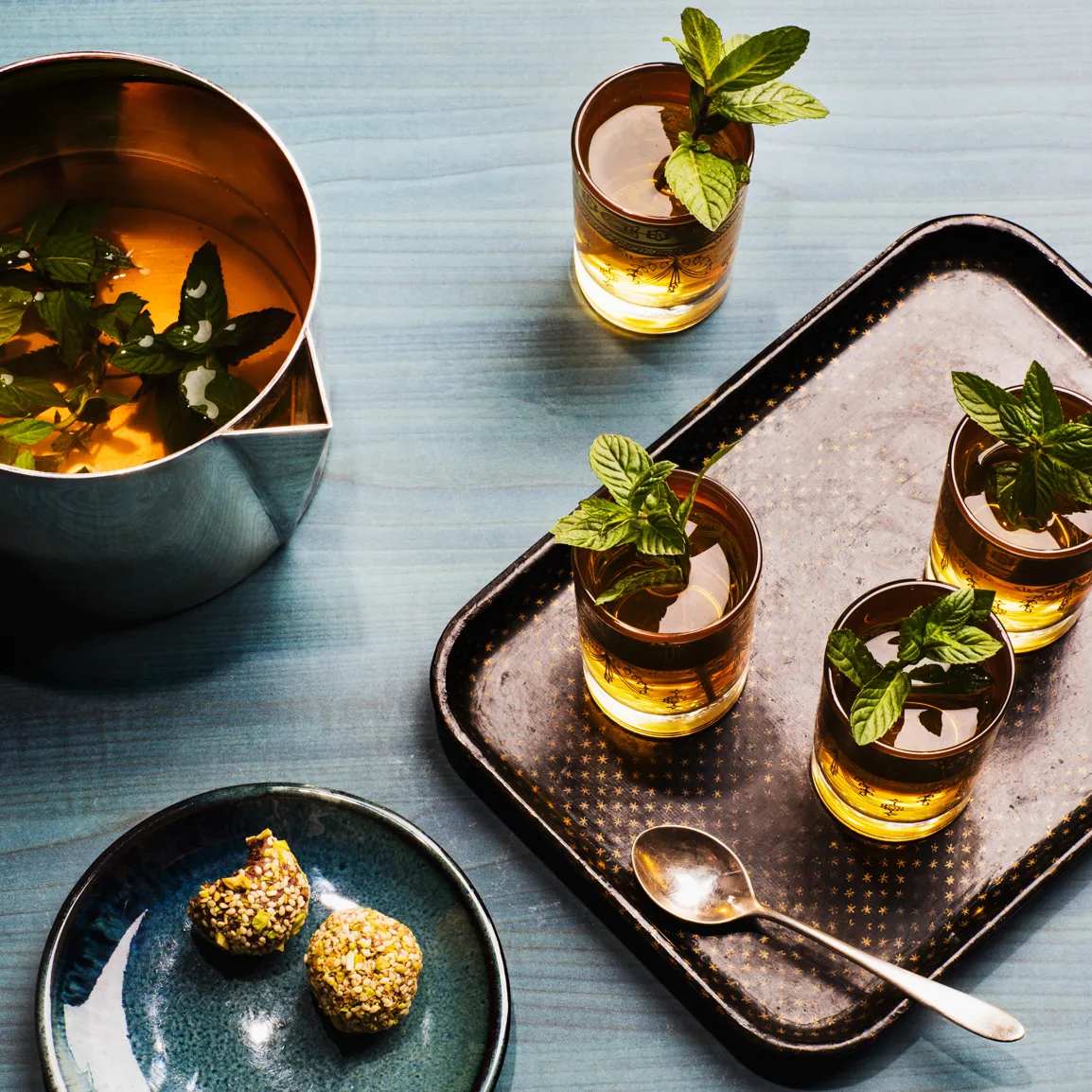Ghanaian Recipes: Light Soup, Oil Rice, and Gari Foto
The Ghanaian Light Soup, as its name suggests, has its roots in Ghana and is specifically associated with the GaDangme people, also known as the Ga people, situated in the Greater Accra Region of Ghana.
Originally referred to as Aklor, the light soup started as a tomato-based sea fish soup. Initially popular among the fishermen along the Accra coast, its popularity grew over time, leading to the inclusion of various meats such as goat meat, lamb, beef, and other choices of livestock.
The surge in popularity also led to the emergence of other dishes inspired by this Ghanaian light soup. Examples include Komi Ke Aklor, a variation featuring light soup garnished with blended and cooked okro, and Yele Ke Aklor, which involves light soup garnished with chopped boiled yam, among others. The diverse adaptations showcase the versatility and evolution of this traditional Ghanaian dish.

Ghanaian Light Soup, also known as Nkatenkwan, is a flavorful and aromatic soup that is popular in Ghanaian cuisine. It is a versatile soup that can be paired with various starches such as fufu, rice, banku, or yams. The name “Light Soup” can be misleading, as it refers to the soup’s clear or light broth, but it is rich in flavor and often spicy.
Ingredients:
- 2 pounds of chicken or goat meat, cut into pieces
- 1 large onion, chopped
- 2 tomatoes, chopped
- 2 tablespoons tomato paste
- 2 cloves of garlic, minced
- 1-inch piece of ginger, grated
- 2 tablespoons groundnut (peanut) paste
- 2 tablespoons palm oil
- 2 teaspoons ground crayfish
- 1 teaspoon ground pepper (adjust to taste)
- Salt to taste
- 1 bunch of fresh spinach or kontomire (cocoyam leaves), washed and chopped
- Optional: 1-2 Scotch bonnet peppers for extra heat
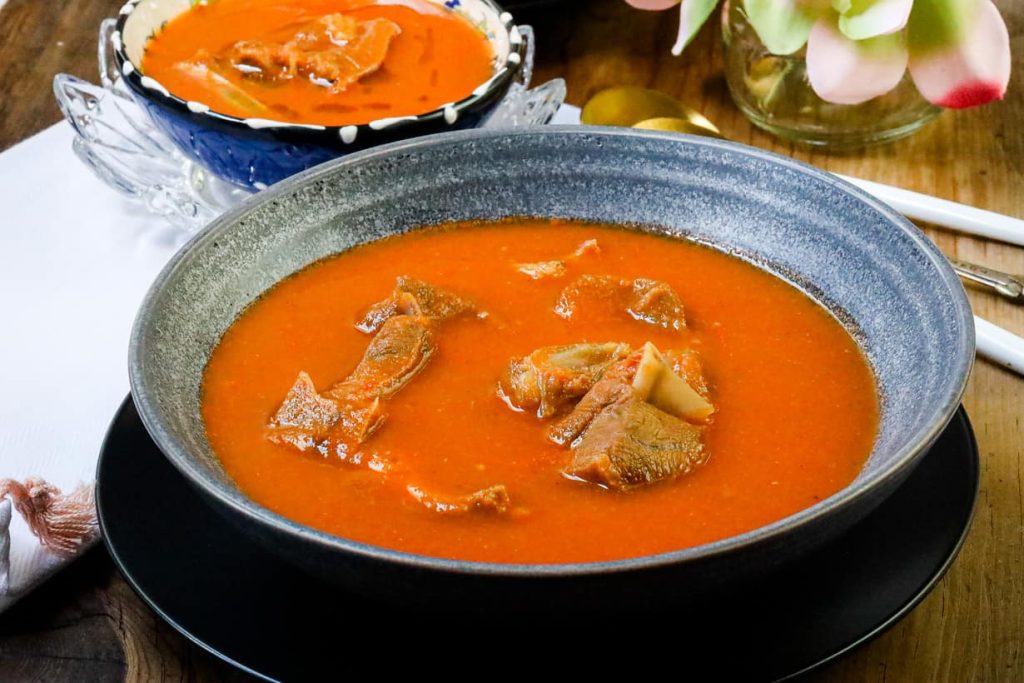
Instructions:
- In a large pot, heat the palm oil over medium heat.
- Add chopped onions, minced garlic, and grated ginger. Sauté until the onions are translucent.
- Add the tomato paste and continue to cook for a few minutes until the oil starts to separate from the tomato paste.
- Add the chopped tomatoes and cook until they are softened.
- Add the chicken or goat meat to the pot. Season with ground crayfish, ground pepper, and salt. Stir to coat the meat with the spices.
- Pour in enough water to cover the meat and bring the soup to a boil. Reduce the heat to simmer and let it cook until the meat is tender.
- Dilute the groundnut paste with a little water to make a smooth paste. Add it to the soup, stirring continuously to avoid lumps.
- If using Scotch bonnet peppers, add them whole to the soup for extra heat.
- Allow the soup to simmer for about 10-15 minutes to allow the flavors to meld.
- Taste and adjust the seasoning if necessary. If the soup is too thick, add more water to achieve the desired consistency.
- Add the chopped spinach or kontomire to the soup and let it wilt. Cook for an additional 5 minutes.
- Serve the Ghanaian Light Soup hot with your choice of fufu, rice, banku, or yams.
Ghanaian Light Soup is a delightful and satisfying dish, and its light broth allows the flavors of the ingredients to shine. Adjust the level of spiciness according to your preference for a personalized experience.
Learn How to Make Ghanian Native Oil Rice Recipe – Angawamo
The term “Angawamo” refers to a Ghanaian dish known as oil rice. This dish involves frying raw rice in hot oil before adding water to cook it. The process of frying the rice in oil gives it a distinct flavor and texture. The dish is typically seasoned with ingredients such as onions, salt, and sometimes Maggi chicken seasoning. Additionally, proteins like leftover chicken or salted beef are often added to enhance the flavor.
The preparation involves frying sliced onions in hot oil until translucent, then adding washed raw rice and stirring to fry. Maggi chicken seasoning, diced pepper, and the preferred protein are added and stirred. Water is then introduced, and the remaining onions are included before letting the rice cooker work its magic.

Angawamo is known for its savory taste, and the addition of proteins and spices contributes to its unique and flavorful profile. It is a versatile dish that can be enjoyed with various accompaniments, such as fried eggs, shito (a Ghanaian pepper sauce), sardines, or other preferred proteins. Adjusting the ingredients to personal taste is common when preparing Angawamo.
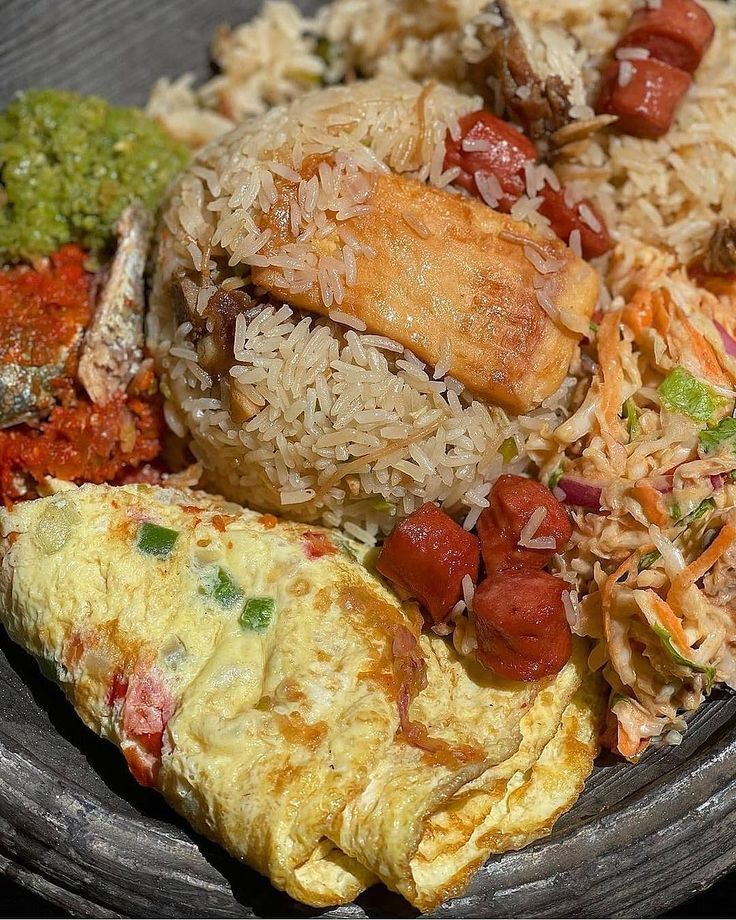
Ingredients:
- 1 tsp cooking oil
- 1 1/4 white cup rice
- 2 small sliced onions (separate them)
- 2 tsp salt
- 1/2 maggi chicken
- Leftover chicken
- 1 medium-sized diced pepper
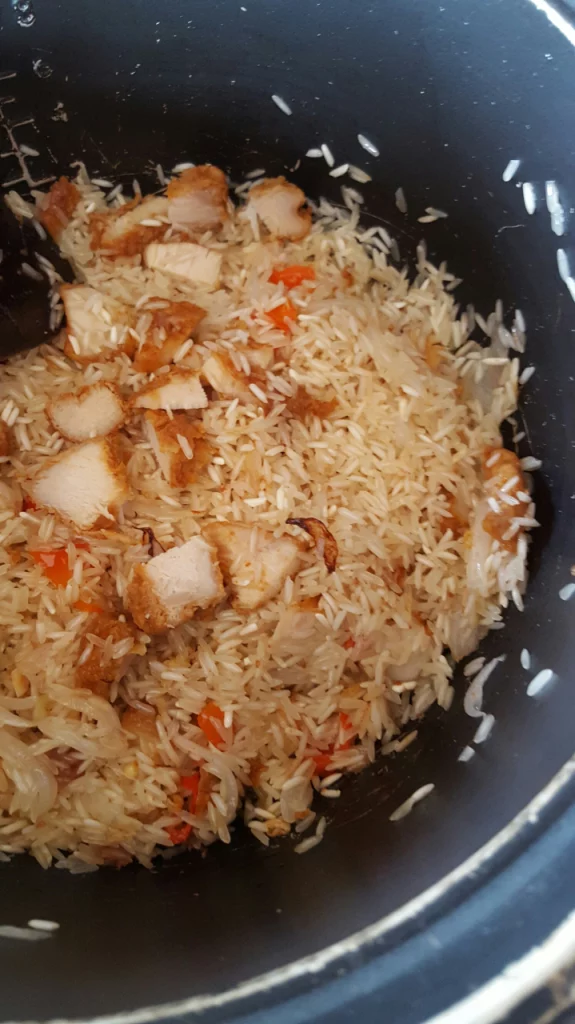
Recipe:
- Fry one sliced onion in your rice cooker with hot oil until translucent.
- Add your washed raw rice and stir to fry.
- Add your maggi cube and stir.
- Add your pepper and preferred protein, then stir.
- Add water, stir, and add your remaining onions. Let the rice cooker do its magic.
Learn About Gari Foto a Ghanian Dish made from Gari combined with Tomato Sauce
A beloved Ghanaian dish, Gari Foto (also spelled Gari Fotor or Gari Fortor) consists of Gari combined with a spicy and flavorful tomato-based stew, resulting in a visually appealing and delicious meal. Gari Foto is a popular culinary choice in Ghana and represents one of the numerous Gari recipes you can explore.
Gari, presented in a white round bowl, is a Ghanaian staple with a slightly sour taste. It is crafted from finely grated or processed cassava, undergoing a mild fermentation process before being roasted to achieve fine and crispy granules.
Cassava, also known as Manioc, Mandioca, or Yuca, is widely consumed in Ghana and can take various forms such as fufu, boiled cassava paired with stew, or transformed into delightful snacks. It’s crucial to note that cassava tubers can be toxic (cyanide) if consumed raw, necessitating careful preparation.
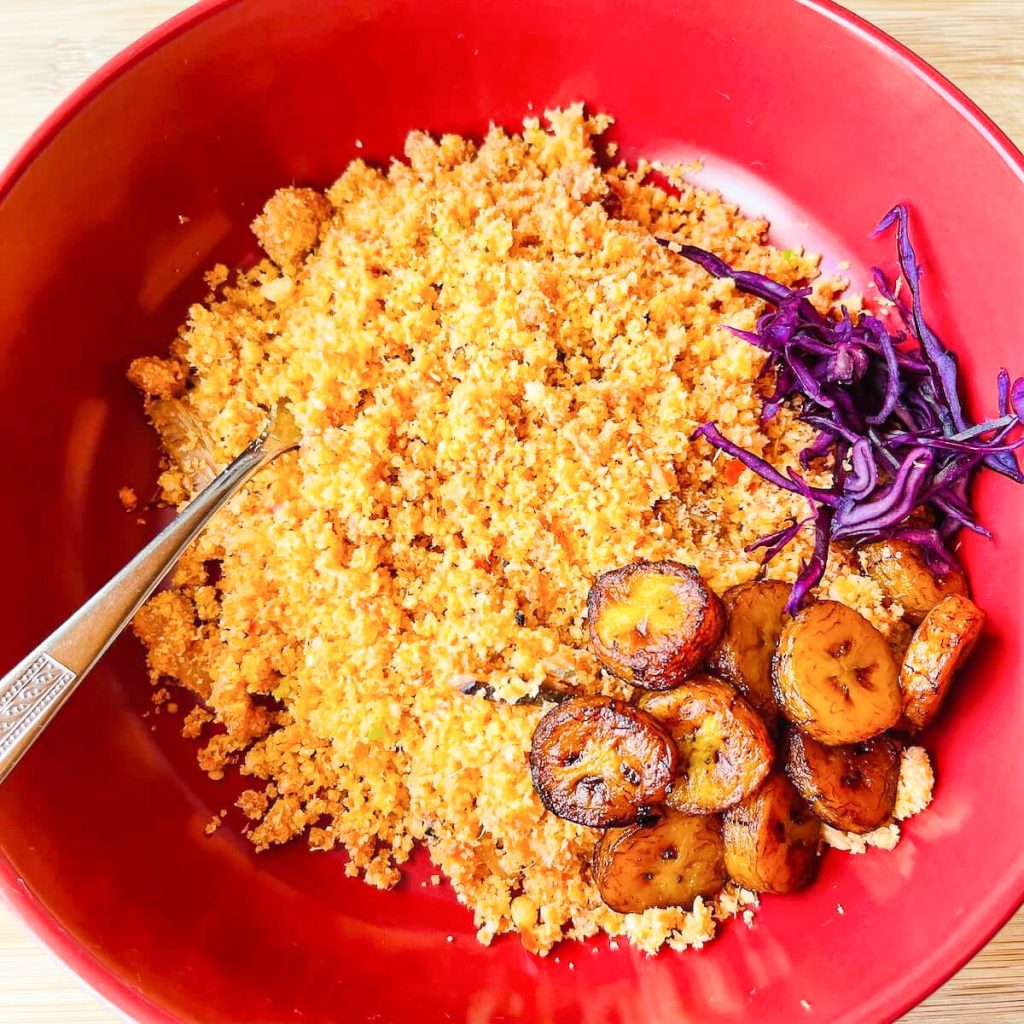
Gari holds a versatile role in Ghana, Nigeria, and other West African regions. It can be transformed into a thick paste by mixing it with cold or hot water, offering a perfect accompaniment to soup or stew. Additionally, it can be “soaked,” involving the addition of milk, sugar, and groundnuts for a quick and tasty snack. Gari also pairs well with shito, a Ghanaian pepper sauce crafted from powdered dried shrimp, dried fish, ginger, onions, salt, and abundant dried red chili peppers, or alongside tinned sardines.
Considered a culinary lifesaver, especially by those who have experienced boarding school in Ghana, Gari retains its crispiness when stored properly. While exposure to air may compromise its texture, Gari boasts an exceptionally long shelf life under appropriate storage conditions.

Ingredients:
- 2 cups gari (cassava granules)
- 1 cup cooked black-eyed peas
- 1 large onion, finely chopped
- 2 large tomatoes, diced
- 1 red or green bell pepper, diced
- 2 tablespoons vegetable oil
- 1 teaspoon ground pepper
- 1 teaspoon ground ginger
- Salt to taste
- Optional: cooked fish or fried eggs for added protein

Instructions:
- Place the gari in a large bowl and sprinkle a small amount of water over it. Use your fingers to fluff and separate the gari, ensuring it absorbs the water. Set aside.
- In a large pan, heat the vegetable oil over medium heat.
- Add the chopped onions to the hot oil and sauté until they become translucent.
- Stir in the diced tomatoes and bell pepper, and cook until the vegetables are soft.
- Add the cooked black-eyed peas to the pan and mix well with the vegetables.
- Sprinkle ground pepper, ground ginger, and salt over the mixture. Adjust the seasoning according to your taste preferences.
- Finally, add the fluffed gari to the pan and mix everything together. Allow it to cook for a few more minutes until well combined.
- If desired, you can incorporate cooked fish or top the Gari Foto with fried eggs for additional protein.
- Serve the Gari Foto warm and enjoy this delightful Ghanaian dish.
Gari Foto provides a perfect blend of textures and flavors, making it a versatile and satisfying dish for any time of the day.
Related Reading GHANAIAN RECIPES: OKRA STEW AND BOILED YAM WITH VEGETABLE SAUCE
